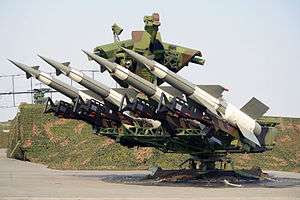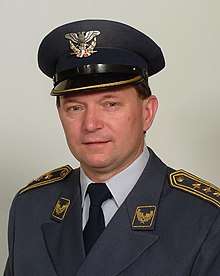1999 F-117A shootdown
On 27 March 1999, during the NATO bombing of Yugoslavia, a Yugoslav army unit shot down an F-117 Nighthawk stealth aircraft of the United States Air Force by firing a S-125 Neva/Pechora surface-to-air missile. The pilot ejected safely and was rescued by allied search and rescue forces.[1][2]
| 1999 F-117A shootdown | |
|---|---|
| Part of the NATO bombing of Yugoslavia | |
.jpg) Canopy and ejection seat and wing of F-117 with serial number 82-0806 at the Belgrade Aviation Museum in late 2018. | |
| Type | Aircraft shootdown |
| Location | 44°54′N 19°52′E |
| Objective | NATO warplanes |
| Date | 27 March 1999 8:15 p.m. |
| Executed by | 250th Air Defense Missile Brigade, Army of Yugoslavia |
The F-117, which entered service with the U.S Air Force in 1983, was widely seen as one of the most advanced pieces of U.S. military equipment. At the same time, Yugoslav air defenses were considered relatively obsolete.[3]
Downing
On 27 March 1999, the 3rd Battalion of the 250th Air Defense Missile Brigade of the Army of Yugoslavia, under the command of Lt. Colonel (later Colonel) Zoltán Dani, downed F-117 Air Force serial number 82-0806, callsign "Vega 31".[3][4]
The Army of Yugoslavia unit was equipped with a Yugoslav version of the Soviet Isayev S-125 "Neva" missile system (NATO reporting name, SA-3 "Goa").[Note 1][1][3][5]
At about 8:15 pm local time, with a range of about 8 miles (13 km) several missiles were launched. According to Lieutenant Colonel Đorđe Aničić, who was identified in 2009 as the soldier who fired the missiles, they detected the F-117 at a range of about 23 km operating their equipment for no more than 17 seconds to avoid being locked on to by NATO anti-air suppression.[3] According to Dani in a 2007 interview, his troops spotted the aircraft on radar when its bomb bay doors opened, raising its radar signature.[6]
The F-117, callsign "Vega-31", was being flown by Lt. Col. Darrell Patrick "Dale" Zelko (born 1 January 1960),[3][7] an Operation Desert Storm veteran.[8] He observed the two missiles punch through the low cloud cover and head straight for his aircraft.[9] The first passed over him, close enough to cause buffeting, but did not detonate. The second missile detonated, causing significant damage to the aircraft and causing it to tumble out of control.[8] The explosion was large enough to be seen from a KC-135 Stratotanker, flying over Bosnia.[8][10]
Zelko was subject to intense g-forces as the aircraft tumbled and had great difficulty in assuming the correct posture for ejecting. After his parachute deployed, he used his survival radio to issue a mayday call and was able to contact the KC-135 that had seen him shot down.[8] Zelko used his survival radio while still descending although this was contrary to his training.[8][11] He reasoned the altitude would give his signal the best possible range and was also sure he would be quickly taken prisoner by Yugoslav forces on the ground and wanted to confirm he was unhurt before this happened.[8]
Zelko landed in a field south of Ruma and around a mile south of a four-lane highway.[Note 2] He quickly concealed himself in a drainage ditch that he had identified as a hole-up site while descending.[8] There, he felt the shock waves of bombs dropped by NATO B-2 bombers on targets on the outskirts of Belgrade.[8] Zelko landed around a mile from his aircraft's crash site, and an intensive search of the area was carried out by the Yugoslav soldiers, policemen, and local villagers. At one point, searchers came within a few hundred meters of the ditch he was hiding in. Zelko was rescued approximately eight hours later by a U.S. Air Force combat search and rescue team flying in a Sikorsky MH-53 helicopter in the early hours of the next morning. According to Zelko, he would later learn that he had been minutes away from being captured.[8][12] He was initially misidentified in press reports, as the name "Capt Ken 'Wiz' Dwelle" was painted on the aircraft's canopy. The lost F-117 carried the name "Something Wicked" and had previously flown 39 sorties during the Persian Gulf War's Operation Desert Storm.[13]
On 2 May 1999, the 250th Air Defense Missile Brigade also shot down a USAF F-16 fighter piloted by future Chief of Staff of the United States Air Force David L. Goldfein.[14][15][16]
Aftermath
Photographs show that the aircraft struck the ground at low speed in an inverted position, and that the airframe remained relatively intact.[1] The United States did not attempt to destroy the wreckage, surprising analysts and pilots. The F-117 was based on 1970s technology, the military had revealed its existence in 1988, and the aircraft often appeared at air shows. General Bruce A. Carlson stated that if Serbia gave the wreckage to Russia, the result would be minimal.[17]
Some pieces of the F-117's wreckage are preserved at the Serbian Museum of Aviation in Belgrade;[18] other pieces of wreckage were reportedly sent to Russia and China, to be used in developing anti-stealth technology.[19] A small rubber part of the plane was shown as "a souvenir" to Western journalists by Serbian warlord Arkan during the NATO bombing.[20] The USAF retired its F-117s in 2008.[21]
Zoltán Dani, now running a bakery, and Dale Zelko, now retired from the U.S. Air Force, met in 2011. They have since developed a friendship.[22]
 S-125 Neva air defense system, from the Serbian 250th Air Defense Brigade, on display at a public open day (2012)
S-125 Neva air defense system, from the Serbian 250th Air Defense Brigade, on display at a public open day (2012) Lt. Colonel Darrell Patrick "Dale" Zelko was the pilot of the downed F-117A
Lt. Colonel Darrell Patrick "Dale" Zelko was the pilot of the downed F-117A Lt. Colonel[Note 3] Zoltán Dani was the commander of the 3rd Battalion of the 250th Air Defense Missile Brigade of the Army of Yugoslavia
Lt. Colonel[Note 3] Zoltán Dani was the commander of the 3rd Battalion of the 250th Air Defense Missile Brigade of the Army of Yugoslavia
Notes
- The S-125 was initially deployed by the Soviet Union in 1961. The V-600 or V-601 missiles launched by the S-125 were 6.09 metres (20.0 ft) long, weighed 935 kilograms (2,061 lb) at launch, could reach a speed of Mach 3–3.5 and carried a 60 or 70 kilograms (130 or 150 lb) warhead.
- The European route E70
- Promoted to Colonel after successful accomplishment
References
- Logan, Don. Lockheed F-117 Nighthawks: A Stealth Fighter Roll Call. Atglen, Pennsylvania: Schiffer Publishing, 2009. ISBN 978-0-7643-3242-5.
- Robert F. Dorr (28 April 2015). "The Rescue of Vega 31; How special ops forces saved an F-117 pilot in Serbia". defensemedianetwork.com. Retrieved 19 March 2019.
- "Pilot recognizes crashed F-117A." usatoday.com. Retrieved 24 April 2010.
- Dsouza, Larkins. "Who shot down F-117?" Defence Aviation, 8 February 2007. Retrieved 1 August 2011.
- "How to Take Down an F-117." Strategy Page, 21 November 2005. Retrieved 12 June 2010.
- "Colonel Dani." Defence Aviation, 8 February 2007. Retrieved 1 August 2011.
- Dorr, Robert F. "USAF Fighter Force at 60". AirForces Monthly magazine, October 2007.
- "Interview with Lt Colonel Dale Zelko, USAF" (PDF). Nighthawks. F-117 Stealth Fighter Association. 5 (1). May 2007. Archived from the original (PDF) on 4 March 2016. Retrieved 27 April 2015.
- "Dale Zelko lecture for the USAF museum during 2006". Archived from the original on 30 December 2014.
- "Serb discusses 1999 downing of stealth". USA Today. 26 October 2005. Retrieved 8 May 2007.
- Audio From The 1999 Shoot Down Of F-117 "Vega 31" Over Serbia Is Chilling thedrive.com/the-war-zone, accessed 28 March 2019
- The Stranger Who Changed My Life: My Enemy, My Friend | Reader's Digest
- "F-117A Serial Listings". www.f-117a.com. Retrieved 13 November 2012.
- Roberts, Chris (7 February 2007). "Holloman commander recalls being shot down in Serbia". F16.net. Retrieved 28 March 2019.
- Anon. "F-16 Aircraft Database: F-16 Airframe Details for 88-0550". F-16.net. Retrieved: 16 May 2008.
- Lieven Dewitte: F-16 Fighting Falcon News: USAF F-16CG crashes over Yugoslavia 1 May 1999, www.f-16.net, accessed 28 March 2019.
- Jeffrey T. Richelson (July 2001). "When Secrets Crash". Air Force Magazine. Retrieved 1 November 2019.
- "Air Museum, Belgrade, Serbia Photo Gallery by Vlado Marinkovic at". Pbase.com. Retrieved 27 September 2012.
- Smith, Charles R. "Russia Offers India $8 billion Weapons Deal". NewsMax.com 12 December 2001. Retrieved 20 January 2007.
- "MOGU DA POLOMIM F-117A: Evo kako je ARKAN uništio ponos Amerike i "nevidljivi" bombarder! (VIDEO)". Telegraf. 27 March 2015. Retrieved 25 December 2015.
- Pae, Peter. "Stealth fighters fly off the radar". Los Angeles Times, 23 April 2008. Retrieved 27 April 2008.
- De Launey, Guy (6 November 2012). "Foes now friends: US stealth pilot and the Serb who shot him down ('they worked towards a face-to-face encounter. That finally came last year')". BBC News. United Kingdom: British Broadcasting Corporation. Retrieved 14 November 2012.
External links
| Wikimedia Commons has media related to 1999 F-117A shootdown. |
- Vega 31: The Loss of #806
- Russians admit testing F-117 lost in Yugoslavia, 2001 Flight Global article
- "Foes now friends: US stealth pilot and the Serb who shot him down". BBC.